|
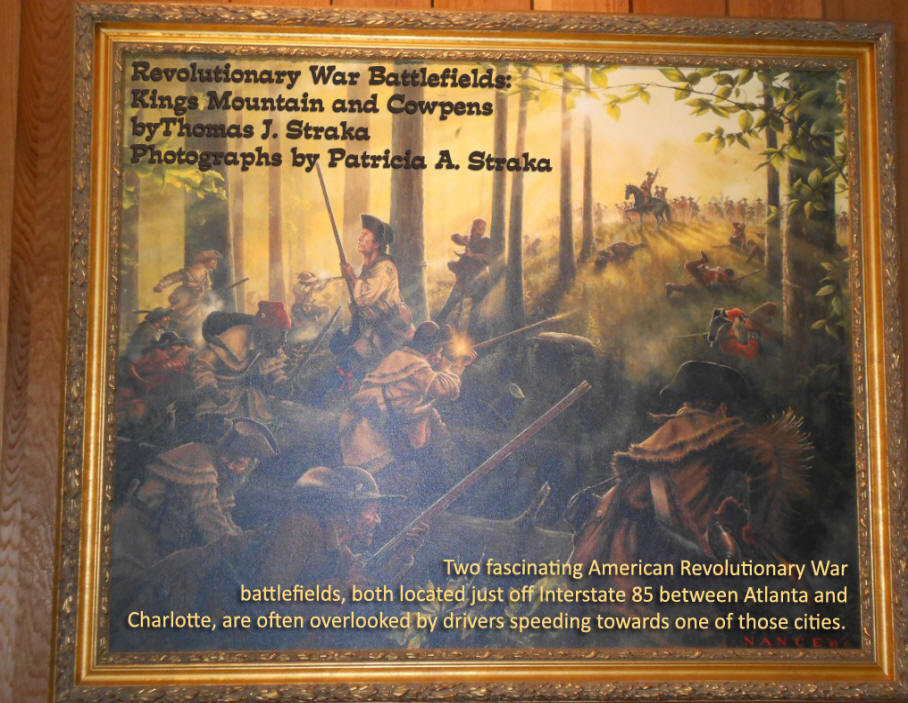
But, they are well worth the stop.
Both are in South Carolina, close to its border with
North Carolina, and both have well-marked exits. They are
managed by the National Park Service as a National Military
Park (Kings Mountain) and a National Battlefield (Cowpens).
Kings Mountain is so close to the border that its
exit is just in North Carolina.
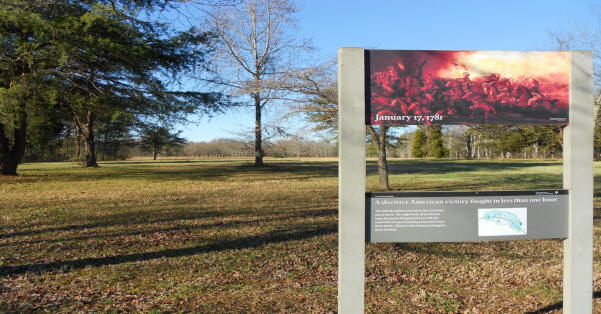 |
|
The Cowpens Battlefield today |
History of the Battlefields
By 1780 a stalemate existed in the northern campaign of the
Revolutionary War and the British were forced to establish a
southern strategy.
The plan was to restore the southern royal colonies, then sweep
across the Carolinas to link with loyalist troops on Virginia's
Tidewater. The British would then control the southern seaboard.
This strategy started with the capture of Savannah in 1778 and
then of Charleston in the spring of 1780. By the summer of 1780
most of South Carolina was subdued and General Charles the Earl
Cornwallis began the march to Virginia.
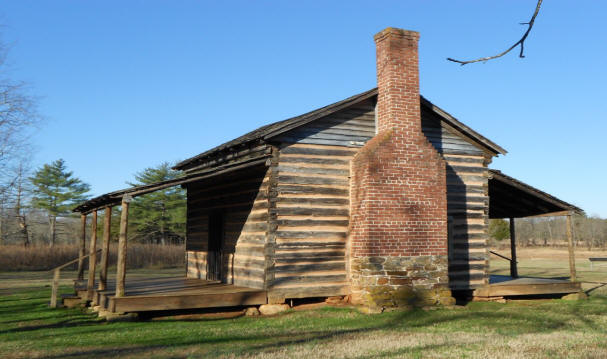 |
Robert Scruggs House today, near the battlefield.
Visitors to Cowpens will
have the chance to see an
1800s log cabin of the type that provided homes
for
yeoman (rural middleclass ) farmers in the South
Carolina backcountry.
|
The first two major battles on the march occurred at the Waxhaws
(near modern-day Lancaster, South Carolina) and Camden. Both
battles were British victories.
After the capture of Charleston, the Patriot governor of
South Carolina, John Rutledge, was forced to flee north and was
protected by a small Patriot force led by Colonel Abraham
Bufford. Cornwallis
sent Lieutenant Colonel Banastre Tarelton, the most feared and
hated British soldier in the South to pursue Rutledge. The two
forces met at the Waxhaws and, while Rutledge managed to escape,
Tarelton achieved a decisive victory. The battle was noteworthy
in that Bufford asked for terms of surrender, but instead over
100 Patriots were massacred.
Tarelton earned the name "Bloody Ban," and the term
"Tarleton's quarter" came to mean massacring troops under a
white flag of surrender.
This would play a role in a later battle at Kings
Mountain. A few months later Tarelton was with Cornwallis at the
Battle of Camden, a second major victory for the British.
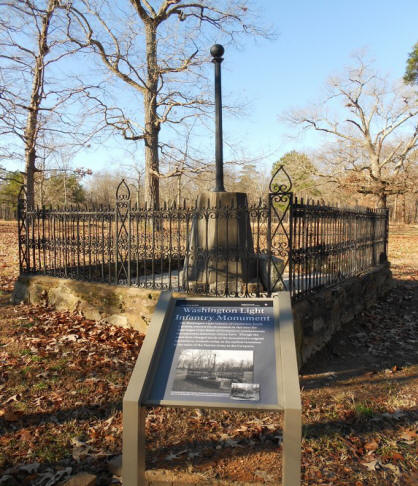 |
| One of the monuments on the
Cowpens Battlefield. |
In September 1780 Cornwallis began his northward invasion and
headed towards Charlotte, North Carolina.
Tarelton protected his right flank and Major Patrick
Ferguson, with 1,100 Loyalists, protecting his left flank.
A group of Patriots from the mountainous regions of the
Carolinas, Virginia, and present-day Tennessee, called the
Overmountain Men, had been harassing Loyalist troops in the
Upcountry and Ferguson was to see they caused no more problems.
His approach to this was to send a message that unless the
Overmountain Men immediately stopped their resistance he would
"march over the mountains, hang their leaders, and lay the
country waste with fire and sword." This did not set well with
the Overmountain Men and troops from the region were gathered
into one single force to counter Ferguson.
Ferguson learned of the gathering force and moved his troops to
Kings Mountain. He had superior advantage there on a spur of the
Blue Ridge, rising about 150 feet over the surrounding terrain.
He was confident and said, "The situation of Kings
Mountain was so pleasing that he concluded to take post there,
stoutly affirming that he would be able to destroy or capture
any force the Whigs could bring against him." He is often quoted
as saying to his troops, "This is Kings Mountain and I am king
of this mountain. God Almighty and all the rebels of hell cannot
drive me from it."
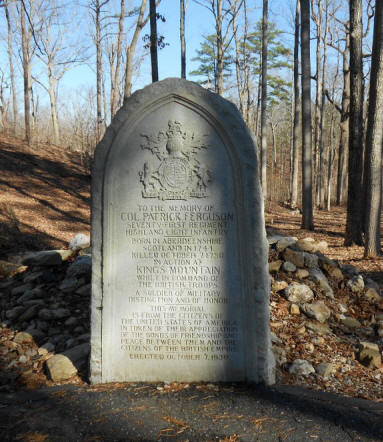 |
Grave of
Col. Ferguson. The grave is covered
by a
rock pile that originates from the Scottish
tradition of placing a cairn over the grave of a
fallen chieftain. The story goes that
one of
his mistresses, a redhead known as Virginia
Sal, was also killed and is buried with him.
|
The Overmountain Men did not want Ferguson to escape, and 900 of
the best riflemen were sent forward to corner him, with Colonel
William Campbell of Virginia in charge. They located Ferguson on
Kings Mountain and surrounded his position. The Patriots opened
fire from below and the Loyalists fired from above. The Patriots
used guerrilla tactics and made use of the heavily forested
slope for cover. Plus, the downward slope of the hill caused the
Loyalists to overshoot their targets. It was over in just over
an hour. Patriots had learned Ferguson was wearing a checkered
shirt and he was a prime target.
He and nearly 300 of his troops were killed.
Cornwallis had lost his entire left flank.
General Clinton, the British Commander-In-Chief in North
America, later called
the Battle of Kings Mountain, "The first link in a chain
of evils that …that ended in the total loss of America."
Thomas Jefferson called it, "The turn of the tide of
success."
The Battle of Kings Mountain took place on October 7, 1780 and
caused Cornwallis to exit Charlotte to the safety of Winnsboro,
South Carolina. He
spent the winter there. Later in October General Nathanael
Greene became commander of the southern Patriot forces.
He was to "an army to look the enemy in the face."
This was easier said than done. Greene decided to split
his forces. He has one of the American's most capable Generals
under his command, Daniel Morgan (as well as William Washington
Henry Lee). Morgan was assigned to operate to the rear and left
flank of Cornwallis.
He was to "annoy the enemy." Cornwallis came to believe
Morgan was threatening Ninety Six, a Loyalist stronghold. He
needed to clear up Morgan as a threat before he began his second
invasion of North Carolina.
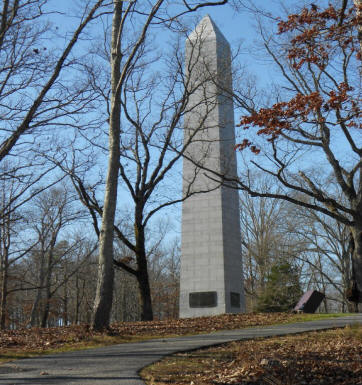 |
Kings Mountain Monument, atop
the battlefield.
|
In January 1781 Banastre Tarleton was sent to destroy Morgan's
forces or at least to make them retreat from western South
Carolina. Morgan's force was greatly outnumbered by Tarleton's
force of 1,100 well-trained troops, but Morgan managed to secure
militia reinforcement. Morgan
ended up with about 800 troops, half of them militia. Morgan
developed a tactic that took advantage of the superior range of
the American rifles and the terrain.
He chose the battle site.
It was a cow pasture, open woods with three low crests
separated by wide swales. He positioned his troops in three
lines, using militia sharpshooters in the front line.
Patriot troop positions were hidden by the terrain and
troops movements would appear to show retreat when none was
actually occurring.
The Battle of Cowpens turned into a second major Patriot
victory. Tarelton was sent fleeing and his army was destroyed.
This is considered "one of the most skillfully fought
battles in the annals of the American military. Cornwallis did
finish his intended path through North Carolina and Virginia and
it ended in Yorktown.
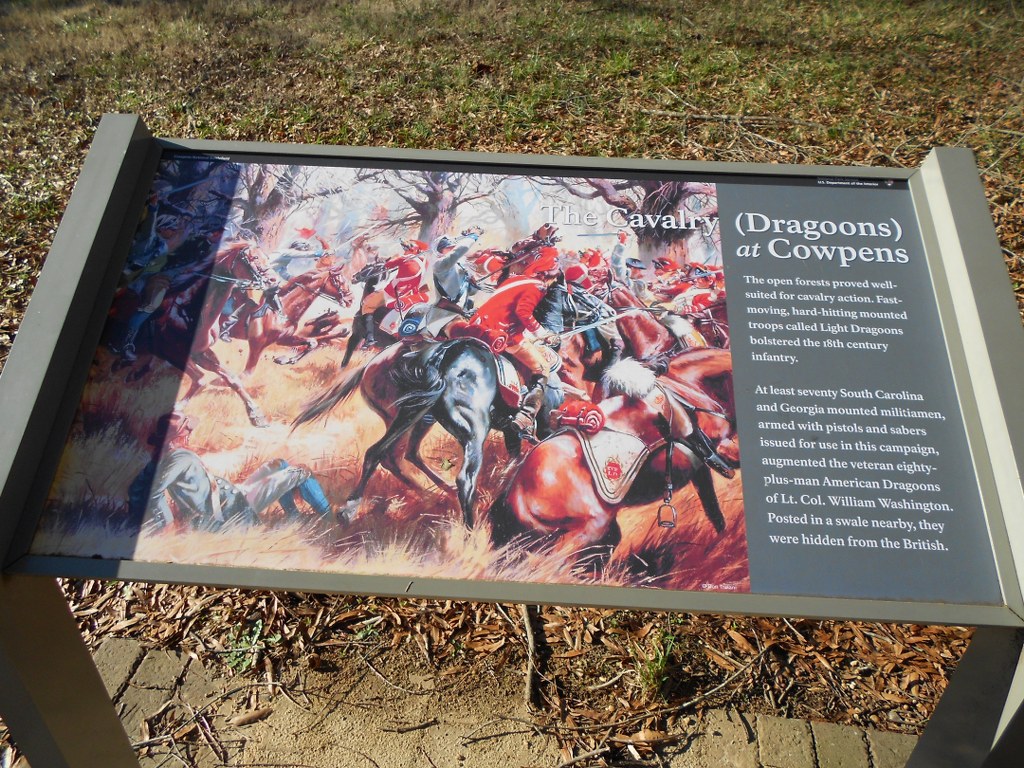 |
| Marker explaining a Dragoons (would be Cavalry
today) battle. |
The Battlefields Today
Both battlefields are similar.
Both are very close to the interstate.
Both have a large visitor's center, with extensive
historical displays, a well-produced video, and a book store.
Both have a well-developed trail that starts behind the
visitor's center and follows the battlefield to allow the best
vistas and historical overview.
The trail at Cowpens circles a relatively open area, like
what you'd expect a colonial cow pasture to look like.
You can easily see the low crests separated by wide
swales; you don't need a lot of imagination to see how the
colonial troops remained hidden from the British view. The trail
at Kings Mountain circles the hill and takes you to the top.
Strategic locations are
well-marked on both trails. Each battlefield is worth at least a
half-day, and that is only if you want an introduction to the
history involved.
Like any historical site, the value of the experience is greatly
enhanced if you do some homework and study the history of the
battles first.
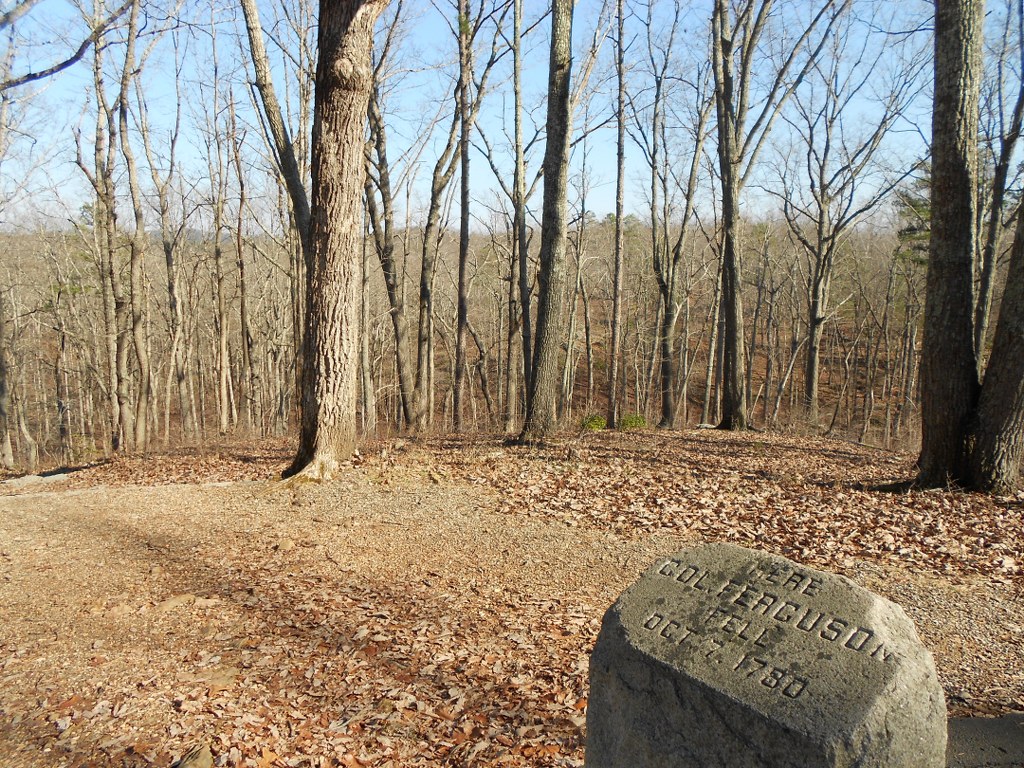 |
| Key spots on the Kings Mountain Battlefield are
well-marked. |
You don't need to invest in a lot of history books to do that
homework. The Park
Service has really well-developed websites, listed below, that
give a great overview of the battles. Plus, while the
battlefields may not be widely-known, the internet has
voluminous amounts of history and images.
You quickly begin to realize how important these battles
were.
It is a fantastic way to add a day to a trip that goes down
I-85.
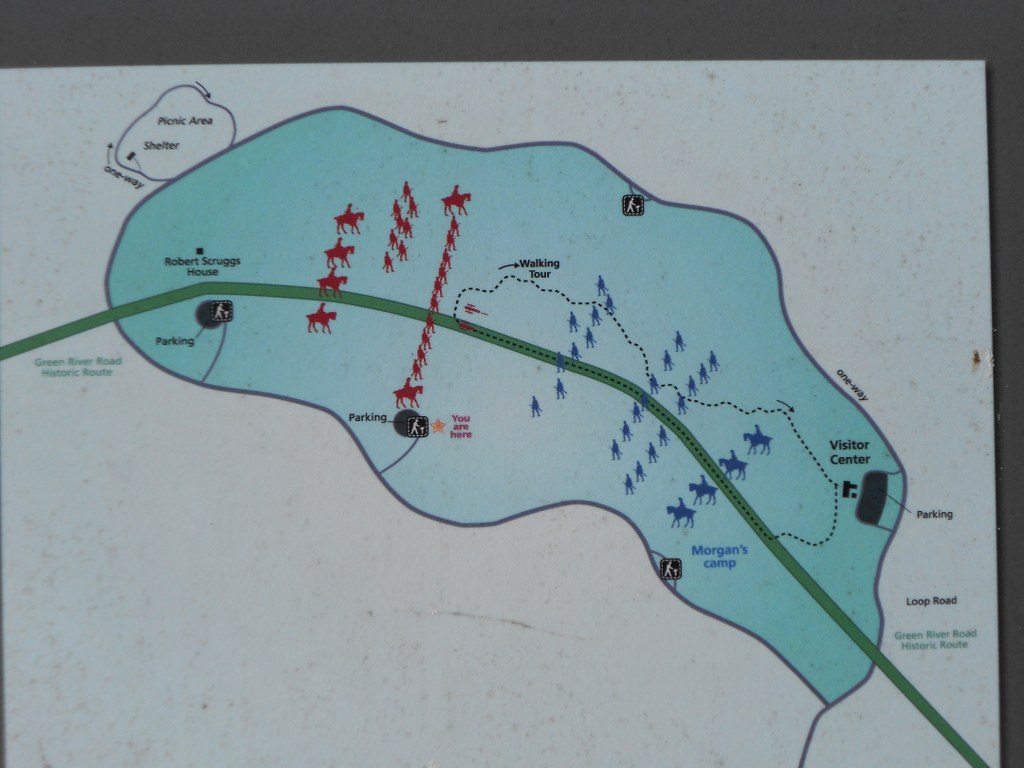 |
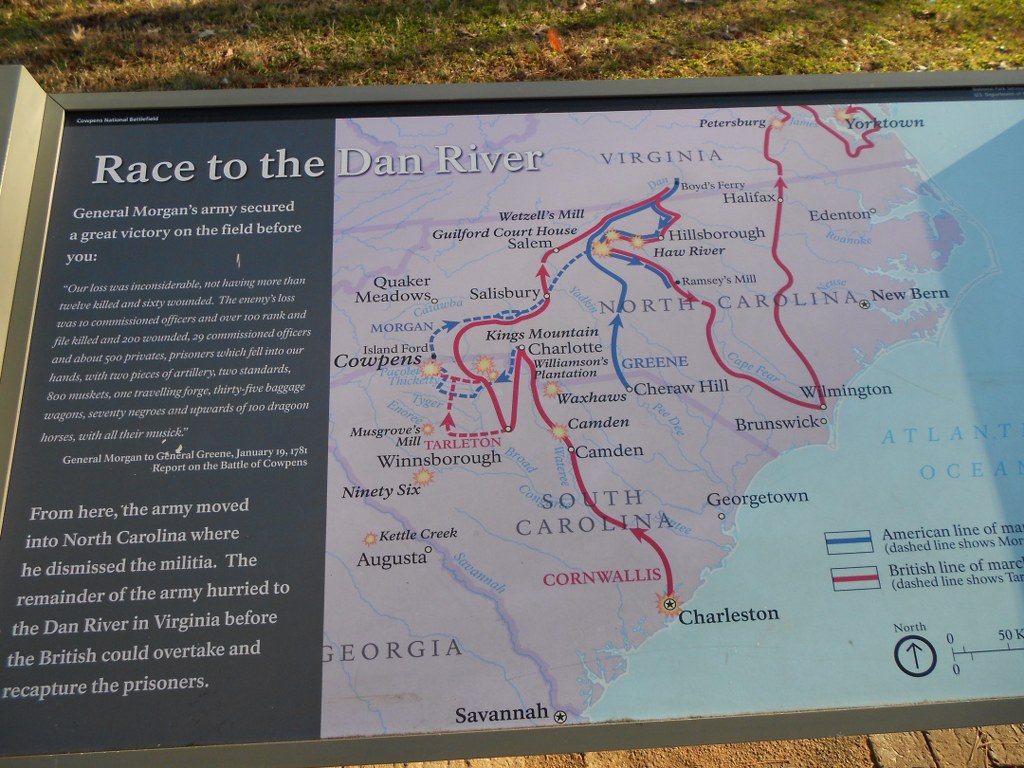 |
Map of the Cowpens Battlefield,
showing the walking tour. |
Map of the American Revolution
Southern Campaign that shows the beginning in
Charleston and the end in Yorktown, plus the pivotal
battles at Kings Mountain and Cowpens.
|
Authors:
Tom Straka is a forestry professor at Clemson University in
South Carolina. His wife, Pat, is a consulting forester. Both
have a keen interest in history.
For more information:
Kings Mountain National Military Park Home Page
http://www.nps.gov/kimo/index.htm
Kings Mountain National Military Park Brochures and Maps
http://www.nps.gov/kimo/planyourvisit/brochures.htm
Cowpens National Battlefield Home Page
http://www.nps.gov/cowp/index.htm
Cowpens National Battlefield History and Culture
http://www.nps.gov/cowp/historyculture/index.htm
Overmountain Victory National Historic Trail
http://www.nps.gov/ovvi/index.htm
|
![]() Ads fund American Roads so please consider them for your needed
purchases.
If you enjoy the articles we offer, donations
are always welcome.
Ads fund American Roads so please consider them for your needed
purchases.
If you enjoy the articles we offer, donations
are always welcome.
----------
|